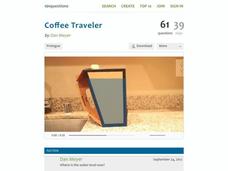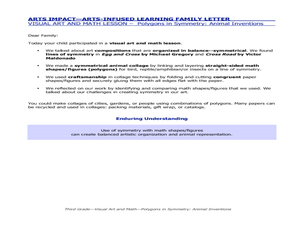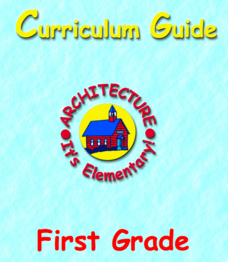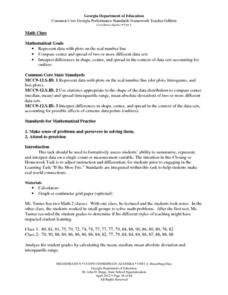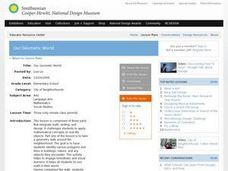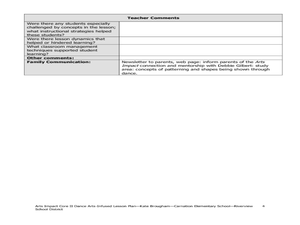Radford University
Fun with Solids
Geometry is all around us—if we're only willing to look. The final three activities of the Fun with Solids unit continue work on surface area and volume. For lesson three, scholars investigate the formulas for spheres and solve a problem...
101 Questions
Coffee Traveler
Investigate the volume of irregular figures in an inquiry-based exercise. Presented with an irregularly shaped box filled with water, learners must predict the level of water when it is tipped on its side. The class can divide...
K-5 Math Teaching Resources
Blank Number Cube
With this blank number cube, you have the flexibility to keep it blank or add markings to meet your lesson's needs.
Curated OER
Parallel and Perpendicular Lines
Learners study parallel and perpendicular lines. In this parallel and perpendicular lesson plan, pupils explore 2-D shapes and determine if the sides are parallel or perpendicular.
Curated OER
Attributes of Shapes
There are five shapes for scholars to identify: rectangle, circle, square, trapezoid, and triangle. Although there isn't much here, consider projecting this as an all-class warm up. Ask kids to verbalize attributes of each...
Utah Education Network (UEN)
Insides and Outsides
Give small groups handfuls of unit cubes and then dare them to build as many rectangular prisms as possible using only 12 cubes. This engaging activity serves as an introduction to the volume of solid figures. In addition to volume,...
Curated OER
Tiling Tessellations
Learners explore tessellations. In this shapes and geometry lesson, students describe the attributes of many of the shapes displayed on an Elmo. Learners create examples of tessellations using pattern blocks.
Curated OER
It's Not All Greek to Me
Learners find out the meaning for prefixes used in math vocabulary. By dissecting words used in everyday math, they figure out what the prefix indicates and what the word means. A variety of well-organized worksheets and activities...
Curated OER
Terrific Tangrams
Third graders construct tangrams. In this tangrams lesson, 3rd graders manipulate basic shapes to construct tangrams. Students explore how shapes can be combined in different ways and develop spatial sense.
Curated OER
Shapes and Introduction to Geometry
Students make a quilt. In this geometry instructional activity, students discuss patchwork quilts and learn some different geometric shapes and patterns that are commonly used. Students explore designs with triangles and squares and then...
Curated OER
Obtuse Angles
Third graders recognize and identify geometric shapes, work with manipulatives to reinforce understanding, and create polygons with various angles to display their knowledge of the different types of angles.
Curated OER
Geometry and Rubik's Cube
Students explore geometry using a Rubik's Cube. In this 2-D and 3-D shapes lesson, students use the Rubik's Cube to find the center, edge and corner pieces. Students then find the dimensions of the Rubik's Cube and read the solution...
Curated OER
Polygons in Symmetry: Animal Inventions
Fourth graders use polygons to create animal figures with symmetry. In this polygons and symmetry lesson, 4th graders create a symmetrical animal collage by cutting and gluing geometric shapes and figures from math activities.
Curated OER
Metallic Mosaic
Students engage in a lesson about polygons while creating a mosaic pattern. They concentrate upon creating a pattern that is geometric and has the look of a quilt design. The lesson includes steps to complete the project and helpful hints.
Curated OER
Using Geometric Shapes To Make Patterns
Sixth graders explore the use of shapes to create geometric patterns. they start with a simple example of dividing shapes in half to create two new ones. This can be extended to creating intricate patterns.
American Institute of Architects
Architecture: It's Elementary!—First Grade
Build an interest and appreciation for architecture in your young learners with this fun 10-lesson art unit. Engaging children in using their five senses, the class first observes the environment around them, paying...
Curated OER
Living in a Geometrical World
Students participate in a series of hand-on, online, and multimedia activities to examine 2 dimensional and 3 dimensional shapes. They describe common geometric solids. They construct rectangular prisms using straws and ribbon.
Georgia Department of Education
Math Class
Young analysts use real (provided) data from a class's test scores to practice using statistical tools. Not only do learners calculate measures of center and spread (including mean, median, deviation, and IQ range), but...
Curated OER
Polyhedra: Faces, Edges, and Vertices (3-D Marshmallow Models)
Third graders explore the attributes of 3-dimensional shapes. In this shapes lesson plan, 3rd graders examine faces, edges, and vertices of 3-dimensional shapes as they construct shapes using marshmallows and toothpicks.
Curated OER
A Wall of Symmetrical Shapes
Students explore line(s) of symmetry in polygons during a hands-on activity and a Student Web Lesson. They build a wall of symmetrical shapes designed and drawn by students.
Curated OER
I've Seen That Shape Before
Students identify geometric solids. In this shape instructional activity, students explore the characteristics of geometric solids. They locate pictures of shapes on the internet, and identify the shapes. Students draw...
Curated OER
3 dimensional shapes
Students play a bingo game to classify 3 dimensional shapes. For this 3 dimensional shapes lesson plan, students identify, describe, and classify shapes by playing a bingo game.
Curated OER
Our Geometic World
Young scholars walk around the neighborhood and identify various polygons and lines in buildings, nature and other objects. They design a building using various geometric patterns, shapes and lines. Students complete a descriptive...
Curated OER
Dancing Polygons and Non-Polygons with Patterns
Second graders study movements. In this dance lesson, 2nd graders draw patterns selecting one to represent through movement with their body.

